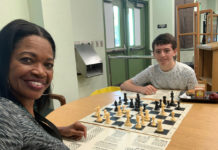OK, let’s talk football.
Wow. There’s three words I never thought I’d type. Before we start, let me clarify. This “talk” will be well beneath most of you whose knowledge of American football far surpasses mine.
I started just a few years ago actually paying attention to the college and pro games that fill our living room every Saturday and Sunday. Sure, I’d always known the goal was to get the ball past a line of snarling giants and into the end zone for a touchdown. But it was only due to Stan’s ever-patient tutorials that I learned in recent years what the hell “third and seven,” or “first and goal” meant, or what it is to “go for it on fourth down.” It makes the game much more enjoyable.
Like all sports, football comes with its own language (not to mention a set of rules more tedious and complex than my old Calculus textbook).
And though I’m still learning the game myself, I thought a beginner’s lesson in “Conversational Football” could make the upcoming Super Bowl LV on Feb. 7 more pleasant for some.
We all know each team is fighting like hell to get that oddly shaped, inaccurately named “ball” into the painted end zone at the far end of the 100-yard field for a touchdown. So, moving right along.
The touchdown itself is worth six points. Then the scoring team has a choice. Their kicker can kick the ball through the “uprights” for one extra point, or they can “go for two” by trying to run or pass the ball into the end zone again, past a line of 300-pound men who are paid to pulverize anyone who tries to take the ball across that white line. If they make it into the end zone again, they get two points. (Depending on the score, teams usually opt to just kick the extra point.)
Now for a few more translations to help the uninitiated better understand the game:
In short, a team gets four tries, or “downs” to advance the ball 10 yards whether by passing it or running with it. When that all-important 10-yard mark is reached, the team gets what’s called a “first down,” which gives them another four tries, or “downs” to go another 10 yards. And so on down the field.
So when the announcer says it’s “second and five,” it means the team with the ball is on their second attempt to go 10 yards, and they have five yards still to go for a first down, which will give them another four tries, or downs, to go another 10 yards. Are you with me, ladies? (Sorry, that was incredibly sexist. Some women, my mom included, are absolute football experts. Sadly, I didn’t inherit that gene.) If the team doesn’t make it 10 yards in four downs, they have to “punt,” or kick the ball back to the other team, which starts their own trek.
Now, if a team is on their fourth (last) down and is still too far from the end zone to likely score a touchdown, they may be in “field goal range.” That’s when they trot out that poor little guy who can make or break the game by kicking the non-ball through the uprights from wherever the team was when they ran out of tries (downs).
Stop rolling your eyes, you gridiron gurus. This may all be second nature to most of you, but be patient with those still learning the language. Maybe now some of us will watch more than the commercials on Super Bowl Sunday. Go Chiefs!



























